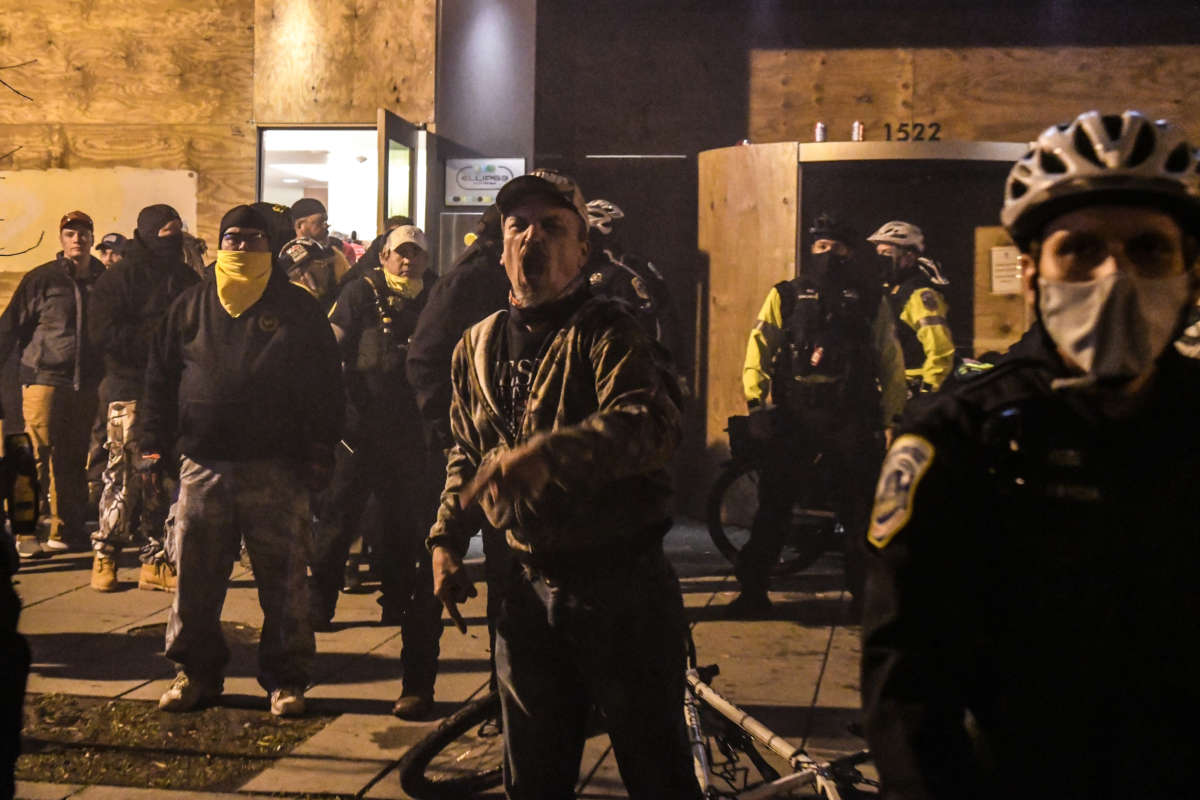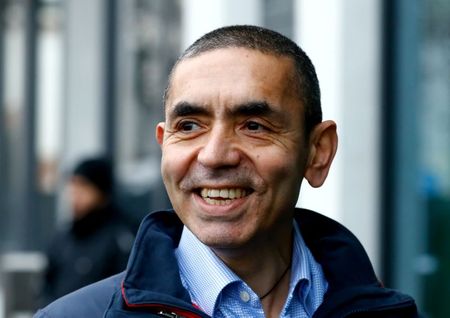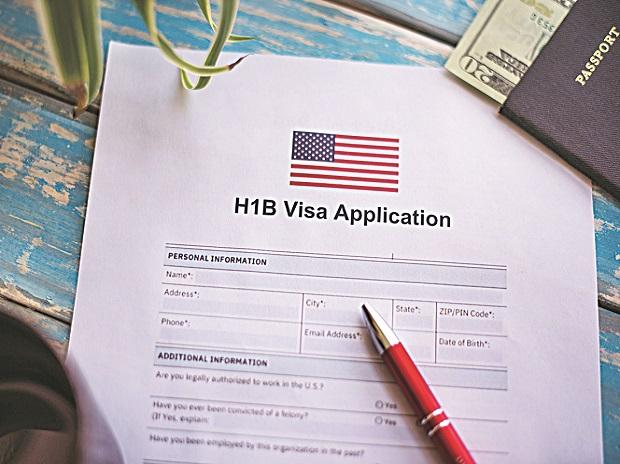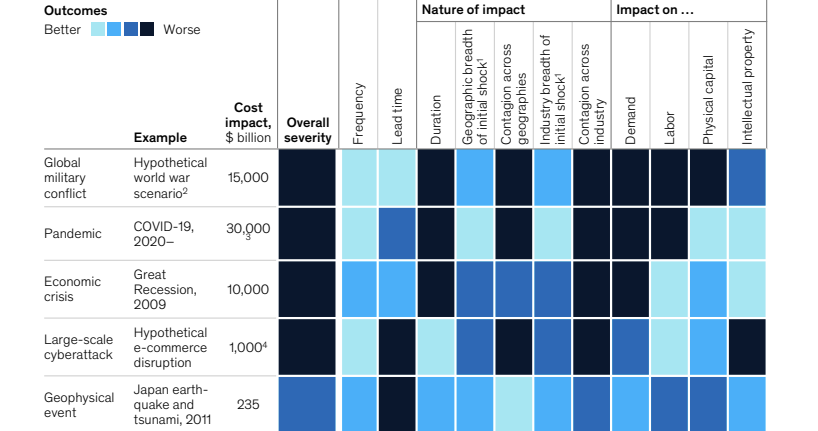
This year was quite active for the far right in the United States, especially after its relative downturn in 2019 as a violent street movement compared to the recent past. Although the far right may not have committed as many high-profile massacres as previous years, 2020 saw more murders and car attacks at demonstrations than any year in recent memory.
While the openly fascist wing of the “alt-right” continued to implode over the past year, some on the far right picked up steam: the Boogaloo movement — a new grouping of younger activists with militia-style politics, but the look and feel of the alt-right; Gropyers — white nationalists and their allies who are trying to influence the Trumpist movement from inside; and followers of the QAnon conspiracy theory, who believe Trump is always about to arrest a cabal of liberal, deep state, satanic pedophiles. Moreover, aggressive street demonstrations led by the Proud Boys reached a fever pitch, inspired by comments from Donald Trump, and renewed opposition to the revived Black Lives Matter (BLM) movement.
The COVID-19 pandemic led to new ground for the far right. Cities started implementing shutdowns in March, but even beforehand, conspiracy theories circulated that the virus was a hoax, a Chinese bioweapon or a plot to enslave Americans. By April, the “reopen” demonstrations were in full swing. These protests were driven by “alt-lite” members (the more moderate wing of the alt-right, which allows people of color, Jews and gay men to join), militias and Trumpists, but white nationalists also participated. One of the most aggressive actions was on April 30, when armed protesters pushed their way into the Michigan legislature.
This movement was soon overtaken by another starting on May 25, when a Minneapolis cop murdered George Floyd, an unarmed Black man, launching a new wave of the BLM movement. It took on an almost revolutionary furor; a police precinct was burned and militant demonstrations broke out across the country. Eventually, they spread even to small towns, and by July, up to 26 million had joined protests in support of this multiracial movement for Black liberation. The far right responded with increasingly aggressive counter-protests, especially as BLM rallies lost their initial intensity.
These counter-protests were driven in part by Trump’s accusation that anti-fascists (also known as antifa) and anarchists were responsible for the protests’ militancy, a rehash of 1950s accusations that Communists controlled the civil rights movement. These conspiracies reached their height on May 31 when Trump tweeted: “The United States of America will be designating ANTIFA as a Terrorist Organization.” (Antifa is neither a single organization, nor does such a designation exist domestically.) When wildfires swept Western states in September, a bizarre rumor, sometimes spread by law enforcement, claimed that members of antifa were intentionally setting them. Armed vigilantes set up roadblocks intended to function as “checkpoints” to identify “antifa arsonists.”
Things turned deadly in the spring. There were a large number of murders and car attacks at BLM demonstrations. The most infamous of these was in Kenosha, Wisconsin, where, during an August 26 demonstration, 17-year-old militia member Kyle Rittenhouse shot and killed two people.
Days later, far right activist Aaron Danielson was killed after he allegedly attacked random people in the aftermath of a violent far right protest in Portland, Oregon. He was shot by self-identified anti-fascist Michael Forest Reinoehl, who in turn was killed by law enforcement on September 3 — without any warning, witnesses said. Trump even gloated that law enforcement gunned him down because “they didn’t want to arrest him.” In October, far right activist Lee Keltner was killed by a security guard as he threatened a TV crew in Denver.
The killings of Danielson, Reinoehl and Keltner were all connected to very aggressive demonstrations, mostly led by the Proud Boys. These had morphed into joint anti-antifa/anti-BLM- themed events, the two movements now joined in the far right’s feverish imagination. Although found in various cities, until the election they continued to be largely centered in Portland.
The Proud Boys became the undisputed far right street force of the year, and were even mentioned in the presidential debate, with Trump telling them to “stand back and stand by.” In Portland — where BLM demonstrations have gone on for over 200 days — the Proud Boys held a series of violent demonstrations. On August 22, Proud Boy Alan Swinney pointed a handgun in the middle of a melee while police stood by. The next week, a vehicle caravan attacked bystanders with paintballs and mace, and the day ended with Danielson’s death. On September 26, the Proud Boys held an aggressive, drunken demonstration at a North Portland park while the counter-demonstration was held elsewhere. Post-election rallies included the November 14 “Million MAGA March” in Washington, D.C., where — for the first time since Charlottesville — well-known white nationalists openly mixed with other Trumpists. A follow-up December 12 rally was marked by more clashes with anti-fascists and vandalism at two Black churches, plus four stabbings and a shooting. The Proud Boys’ leader called for his members to violently disrupt Joe Biden’s inauguration. And on December 21, members of a protest, which included armed members of groups like the Proud Boys, attempted to break into the statehouse in Salem, Oregon.
However, the decline of U.S. fascists, which began in 2018, continued in 2020. The largest “alt-right” fascist group, Patriot Front, held three pop-up marches, each of which showed a decline in attendance from previous years. The American Identity Movement (formerly Identity Evropa) disbanded, as did the Atomwaffen Division, although some observers say it just rebranded as the National Socialist Order. The fascist National Justice Party also formed this year, and Kyle Chapman (aka “Based Stickman”) left the Proud Boys to form the openly white nationalist and anti-Semitic Proud Goys. But the most important movement that fascists took part in was the Groypers, whose goal is to turn Trump’s base further right by working inside that movement. This strategy is opposed to those explicit white nationalist groups who either work separately from the larger Trumpist movement or, in the case of Patriot Front, reject Trump altogether.
Numerous members of Atomwaffen Division, including former leader John Denton, were arrested on weapons charges, threatening journalists, or “swatting” (attempting to get SWAT teams to raid a residence under false pretenses). Seven members of The Base, a similar fascist group that also promotes terrorism, were arrested for crimes including planning to murder anti-fascists and attack a gun rights rally. The group’s leader, Rinaldo Nazzaro, was revealed to be living in Moscow; his past as a Pentagon contractor led New York Magazine to muse that he could be either an FBI agent creating a neo-Nazi honeypot, or a Russian asset.
Just as the coronavirus situation was escalating in March, NSM (National Socialist Movement) member Timothy Wilson was killed by police as he was heading to bomb a hospital. Jeremy Christian, who murdered two people in Portland in 2017 for intervening against his Islamophobic harassment of two women, was sentenced to life in prison. An army private in the pro-Nazi Satanist group, the Order of Nine Angles, was arrested for plotting to ambush his own unit. And Christopher Cantwell, who in 2017 was slated to speak at the Charlottesville “Unite the Right” rally, was convicted in late September of extortion for making a rape threat.
There were high-profile arrests of other far right militants as well. In October, 13 militia members were busted, including six who were plotting to kidnap the Michigan governor. Numerous Boogaloo movement members were also arrested after they sought to inflame the early George Floyd protests for their own ends: Steven Carrillo was arrested for murdering both a federal security guard during the Oakland protests in May, and in June when he ambushed a police officer outside his home in Ben Lomond, California. An associate was arrested for firing a weapon during the initial Minneapolis protests, while three others received terrorism charges for plotting attacks in Las Vegas.
Social media platforms also cracked down on the far right, although belatedly. Twitter started labeling many of Trump’s posts as “disputed.” Numerous far right accounts were removed from different platforms, though sometimes for coronavirus denial — not fascism or violence. Twitter suspended both former White House chief strategist Steve Bannon (who had been arrested earlier in 2020) and former Ku Klux Klan grand wizard David Duke, who had spent over a decade on the platform. Different platforms suspended conspiracy theorist David Icke, Ammon Bundy and the Oath Keepers, as well as the Proud Boys plus their allies, American Guard. In August, a large Facebook purge was focused on QAnon and militias, but also included some anti-fascists and anarchists. This deplatforming spurred a far right migration to the politically sympathetic platform Parler.
The election brought on more far right action. The right-wing conspiracy theory surrounding QAnon became very influential in the fall, and the president embraced it. Trump also declared that antifa was “virtually part of” Biden’s campaign, who he called a “Servant of the Globalists.” (Accusations of “globalism” are a long-time anti-Semitic dog whistle.) After losing the election, Trump has continuously claimed it was rigged and that he won, fueling aggressive protests by his followers. He even turned on his beloved Fox News, instead promoting the more extreme OANN (One American News Network) and disposing of his sycophant Attorney General William Barr.
Trump brought the far right to a new level of popularity, and it remains to be seen what will happen after his departure. Undoubtedly, some groups will immediately shift to opposing incoming president Joe Biden, and others will continue to maintain that the election was stolen. It’s uncertain if Trump will continue to be involved in stoking this movement, however, or if he’ll retire from politics. It’s possible that after a year or so, without a president to inspire them, the far right will fade to pre-Trump levels (although even those levels were more substantial than many people realize). Some watchers, however, think such a cooling off might take years.















